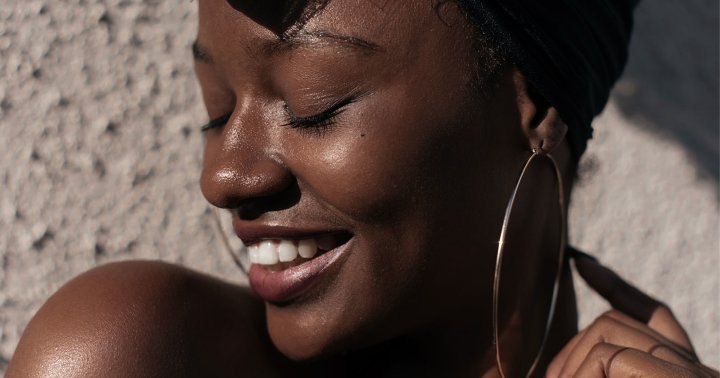Meeting the Buddha in the Scrapyard
Brooklyn artist Elizabeth Englander on Eminem, meditative poses, and her own roundabout path to Buddhism The post Meeting the Buddha in the Scrapyard appeared first on Tricycle: The Buddhist Review.
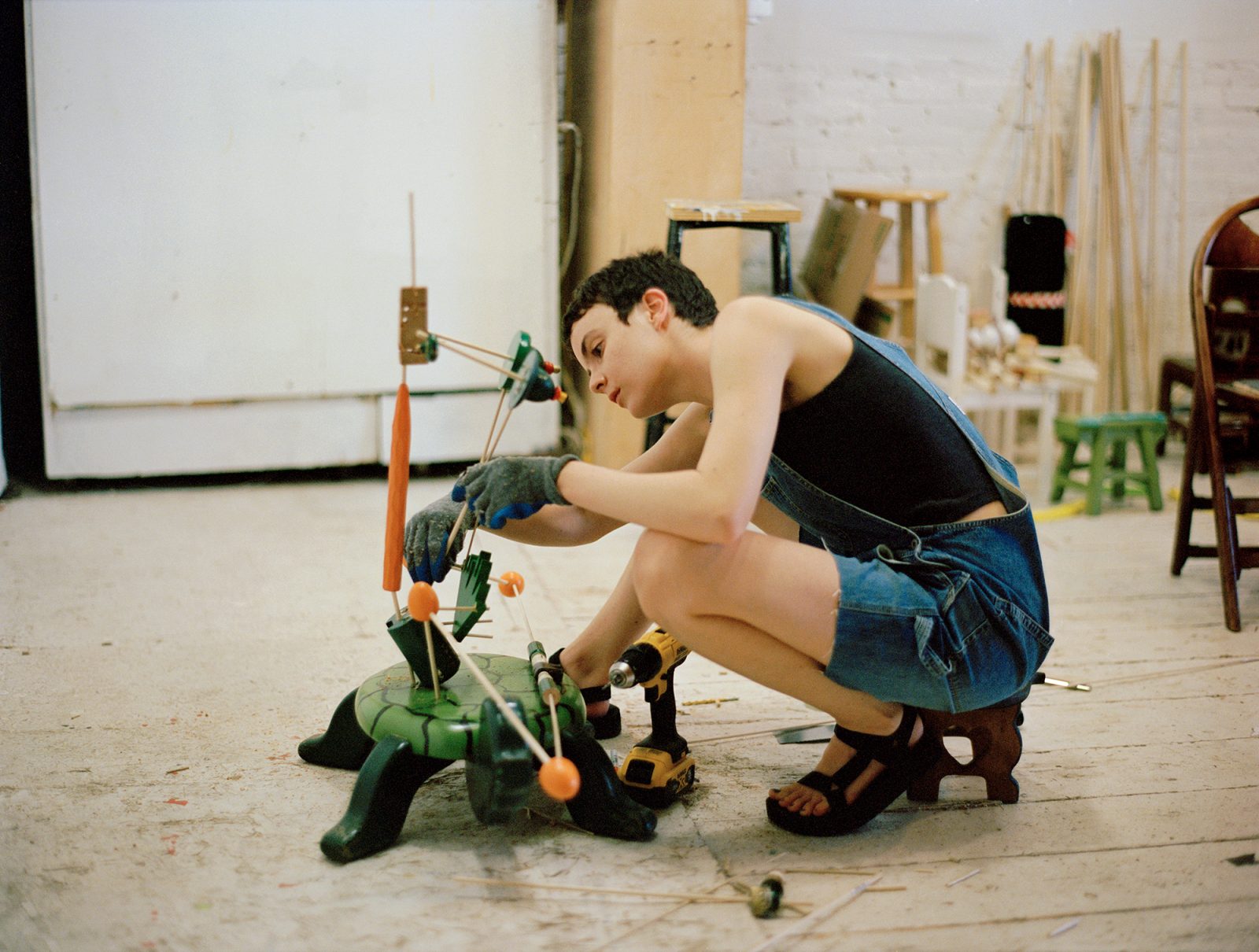
When Brooklyn-based artist Elizabeth Englander began creating Buddhist figures for a new sculpture series, she was maintaining something of a “scholarly distance” from the religion connected to it. “I read about Buddhism, and thought a lot about it in my art, but I felt like I couldn’t practice,” she says, but eventually, that would change.
“At some point, I just went to a temple.”
We’re discussing Englander’s newest exhibit, “Eminem Buddhism, Volume 3,” on display at the Aldrich Contemporary Art Museum in Ridgefield, Connecticut, until October 27. In the show, you can find dakinis (tantric deities, loosely translated as “sky dwellers”) made out of nutcrackers, Buddhas held together by children’s toys, and monks modeled with tricycle seats. The 35-year-old sculptor has a knack for creating otherworldly objects from the mundane, MacGyvering wonderfully weird Buddhist figures out of found objects. The works reflect the threads of family, suffering, and healing that led Englander to her sacred subjects and newfound Buddhist practice.
…
Growing up in coastal Massachusetts, Englander never felt fully connected to the Episcopalian faith of her family. “I was drawn to the art of Christianity … it was the only thing I could really relate to,” she says, describing the stained glass and carved wood of the neo-Gothic church she attended as a child. Without much exposure to modern or contemporary art, her passion for the unconventional didn’t materialize until a high school class with Hungarian printmaker Miklos Pogany sparked her interest. “It was the first cracking open of the door to the idea that there are many different things that can be art,” Englander says. “I just fell in love with it.”
After high school, Englander attended Rhode Island School of Design, carving out her own style and studying painting. Upon graduation, she moved to New York and worked for a time as a security officer at the Met. Then, her mom died. Seeking solace and comfort, Englander returned to church. “I had this new interest in Christian religion after she died. I tried going [to church] a couple of times, and it never really connected. But my interest in the art helped, and it met my interest in sculpture.” Englander began working in sculpture and eventually returned to school. Her 2019 Hunter MFA thesis featured sculptures of the pagan goddess Diana derived from 18th- and 19th-century examples. With the onset of quarantine, Englander turned squarely to Christian religious art, moving to Red Hook and beginning to create what would become her series “Bikini Crucifixions.”
 Bikini Crucifixion no. 16, image courtesy Theta Gallery.
Bikini Crucifixion no. 16, image courtesy Theta Gallery.“Bikini Crucifixions” features forlorn figures constructed with wire, hardware cloth, and discarded bathing suits. “It’s about taking these loaded objects and turning them into something else,” Englander explains. “When bathing suit fabric breaks down, it kind of sags, and it’s a lot like skin in the way it ages.” Despite the flowery eyes, pointy genitalia, and huge pregnant bellies of the hanging forms, the figures still feel familiar and even human, perhaps a reflection of the physical toll required for their creation. “Everything was very spiky, and handsewn,” Englander says. “I was cutting my hands and getting into weird and painful positions making them, and just realized that I needed to find a different relationship to suffering.”
…
The Buddhist conception of suffering had already captured Englander’s attention nearly a decade earlier. A trip to China with her sister in 2011 found the two at the foot of the largest premodern sculpture in the world: the Leshan Giant Buddha statue. “The statue acted on me,” Englander says, “and I had to do more research on it.” According to legend, the Maitreya statue was planned by monk Hai Tong in the hope that its presence would calm the turbulent and deadly river below. By the time construction was complete, so much rock had been carved out of the cliff and deposited into the river that it had, in fact, changed the water’s currents, and it remains a safe passage to this day. For Englander, “This was an amazing story about how art and icons can actually do good.” The experience cemented a wonder and admiration for Chinese Buddhist art in Englander that she would revisit in “Bikini Crucifixions.”
Reflecting on the dozens of crucified beings that came out of the series, a parallel from Chinese Buddhism came to mind for Englander: the thousand-Buddha motif. “There’s the universality of suffering, and there are endless Buddhas,” Englander says. “Everyone has buddhanature. It was a motif I saw in my art.” Over time, her work began to address these themes more directly: “The last piece I was working on was a bronze for a proposal. I found myself researching Chola bronzes from South Asia, which is how I found the type of sculpture that I liked.” With all paths leading toward Buddhist art, Englander got to work on the first figures for “Eminem Buddhism.”
Drawing on a number of bodily postures from medieval South and East Asian art, the gods and goddesses of “Eminem Buddhism” sit, stand, and crouch in pursuit of transcendence. Some icons appear relaxed, such as Yogini no. 23 (from “Volume 2”), who leans back with one leg down and one up in a traditional royal-ease pose associated with Avalokiteshvara. Others, like the nutcracker-faced Yogini no. 32 (from “Volume 3”), are wound up with tension and intensity. When I asked Englander about her methods for capturing the right energy, she quips, “Posing is body language, right? So it’s about tweaking that ‘body language.’”
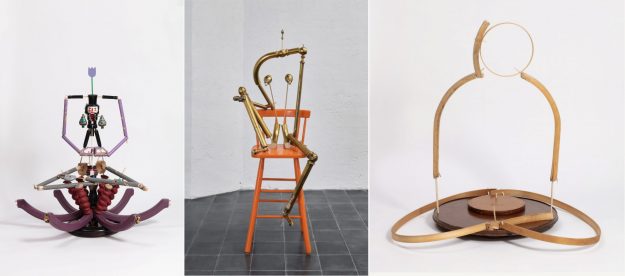 Left to right: Yogini no. 32; Yogini no. 23; Yogini no. 35. Images courtesy Theta Gallery.
Left to right: Yogini no. 32; Yogini no. 23; Yogini no. 35. Images courtesy Theta Gallery.Her inspiration for poses goes beyond formal depictions of gods and Buddhas. A handful of the figures were pulled from details of temple/stupa decorative schemes. In “Volume 3,” two of the larger sculptures, including Yogini no. 35, are based on the Zen drawing tradition of a rear perspective, or looking at someone meditating from behind. In Bodhidharma (Purple), a flattened purple tricycle seat evokes the form of Bodhidharma facing the wall. Across the spectrum, Englander uses historical Asian iconography as a stepping-off point rather than as a model to copy. “I’ll never get the form exactly like it looks in its culture, where it has a more conventional type of depiction,” she says. What’s most important is “getting an expression that feels appropriate.” The same rules apply to Englander’s eccentric medium of found objects.
…
The building blocks of Englander’s sculptures consist of deconstructed trinkets, toys, and household items. In her earlier work, Englander made sure to have a personal connection to the items, gathering much of them from her childhood home, or from her own wardrobe, as in Bikini Crucifixions. In “Eminem Buddhism,” the sourcing of items was less rigid, with the artist picking up pieces in thrift stores, on Craigslist, and often off New York City streets. She keeps an eye out for discarded objects made from wood, partly for its aesthetic value and partly for its Buddhist connection. “The first icon of the Buddha was sandalwood, according to legend,” says Englander. “And the symbol of the tree is really important.” She tells me that she sees a bit of life transferred from a formerly living material to sculpture—in other words: “The [trees’] bodies are made into new bodies.”
When I ask Englander if she intends for her beings to be truly alive in a sacred sense, the answer is a firm no. “They’re not consecrated. That requires these amazing rituals along the way. What I’m doing is something different.” Their lack of animism doesn’t stop them from being valuable teachers, however. They even taught Englander one of her first Buddhist lessons: how to sit.
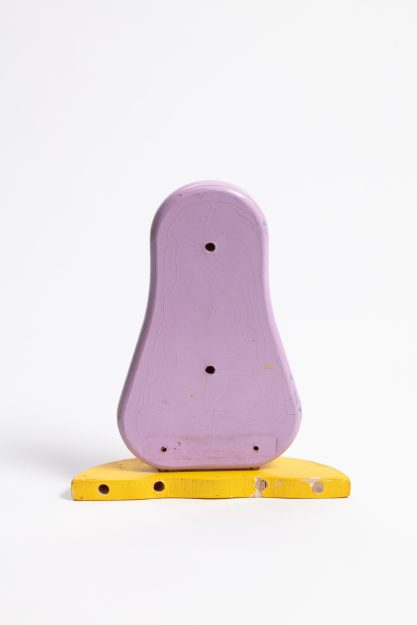 Bodhidharma (Purple), image courtesy Theta Gallery.
Bodhidharma (Purple), image courtesy Theta Gallery.Having struggled with bad knees since she was a teenager, Englander was taken aback by all of the variations of sitting depicted in Buddhist art, and in her own. “Seeing all these figures with their knees bent was crazy … because I really can’t do that,” she tells me. As she was forced to sit on a stool while sculpting, she would look at the figures to find motivation for sitting with the pain. As sitting became more tolerable and more meditative, Englander took her new practice out of the studio and into Brooklyn Zen Center, in Cobble Hill. She has been a regular there ever since.
Looking back on her path, Englander says, “I think I was using the art to ease myself into something that has always been there.” This is reflected in the name “Eminem Buddhism.” As she tells it, during their childhood, Englander’s younger brother wrote stories about an unlikely friendship between the Buddha and the rapper Eminem. Despite being a controversial figure in the ’90s, Eminem was embraced by the Buddha and even took refuge in the dharma. The two pals went on to have many adventures together. Thus, the new religion of Eminem Buddhism was born into the world.
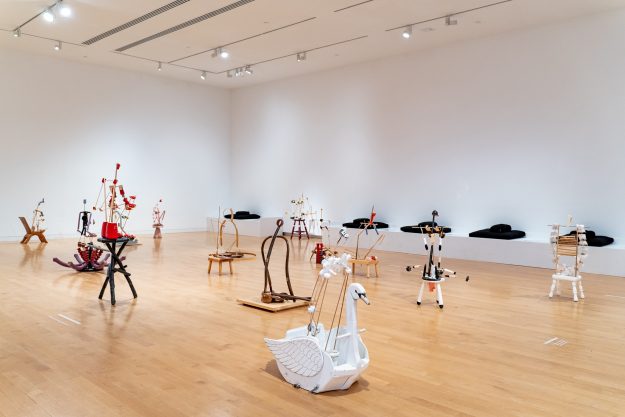 “Eminem Buddhism, Volume 3,” installation view. Image courtesy the Aldrich Contemporary Art Museum.
“Eminem Buddhism, Volume 3,” installation view. Image courtesy the Aldrich Contemporary Art Museum.“It’s such a weird title, but I think it’s so brilliant,” says Englander. The parallels between the siblings’ imaginative processes aren’t lost on her. “When I started the series, I was smashing things together with this culture and religion that I just didn’t know that much about. I felt like I was doing what my brother did.” From a Buddhist lens, the title pays homage to her brother for being one of her first teachers. “If Eminem was his proxy, then maybe he was my proxy.”
After “Eminem Buddhism, Volume 3” closes at the Aldrich, Englander plans to move on to different projects. While she may leave the religious themes behind, she intends to keep up with her Buddhist practice. “I feel really lucky. Making art is fun, and when you use it to figure out your life, it works really well. It’s so rewarding.”
“Eminem Buddhism, Volume 3” is showing at the Aldrich Contemporary Art Museum until October 27. Visit the Aldrich Contemporary Art Museum’s website for more.

 KickT
KickT 








